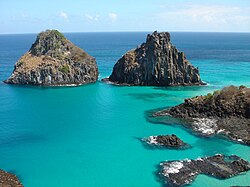Cove
 From Wikipedia - Reading time: 7 min
From Wikipedia - Reading time: 7 min
This article includes a list of general references, but it lacks sufficient corresponding inline citations. (October 2023) |

A cove is a small bay or coastal inlet. They usually have narrow, restricted entrances, are often circular or oval, and are often situated within a larger bay.[1] Small, narrow, sheltered bays, inlets, tidal creeks, or recesses in a coast are often considered coves.[2][3]
Colloquially, the term can be used to describe a sheltered bay. Geomorphology describes coves as precipitously walled and rounded cirque-like openings like a valley extending into or down a mountainside, or in a hollow or nook of a cliff or steep mountainside. A cove can also refer to a corner, nook, or cranny, either in a river, road, or wall, especially where the wall meets the floor.
Formation
[edit]
Coves are formed by differential erosion, which occurs when softer rocks are worn away faster than the harder rocks surrounding them. These rocks further erode to form a circular bay with a narrow entrance, called a cove. Another way is that waves can transport rocks and sediment towards cliffs or rock faces, which helps erode softer rock and gradually form coves due to friction. Additionally, rivers or streams that flow into the sea can contribute to creating natural harbors. "Over time, the sediment carried by the flow of the water will help erode any soft, rocky areas," leading to the formation of a cove.[4]
References
[edit]- ^ "What is the Difference Between a Bay, Gulf, Cove, and Fjord?". 16 March 2018.
- ^ "Thesaurus.com - The world's favorite online thesaurus!". Thesaurus.com.
- ^ "Dictionary.com | Meanings & Definitions of English Words". Dictionary.com.
- ^ Staff, Tynemouth (June 10, 2023). "How are Coves Formed?".
Sources
[edit]- Jackson, Julia A (1997). Glossary of Geology (4th ed.). Alexandria, VA: American Geological Institute. pp. 146–147. ISBN 0-922152-34-9.
- Clark, John O. E.; Stiegler, Stella (2000). The Facts on File: Dictionary of Earth Science. New York: Market House Books Ltd.
 KSF
KSF
